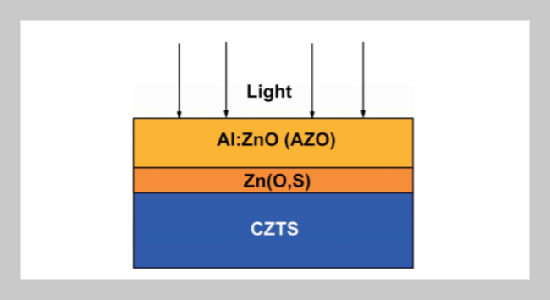REFERENCES
- [1] Dadlani, A. L., Trejo, O., Acharya, S., Torgersen, J., Petousis, I., Nordlund, D., Sarangi, R., Schindler, P. and Prinz, F. B., “Exploring the Local Electronic Structure and Geometric Arrangement of ALD Zn(O,S) Buffer Layers Using X-ray Absorption Spectroscopy,” Journal of Materials Chemistry C, Vol. 3, No. 47, pp. 1219212198 (2015). doi: 10.1039/C5TC02912K
- [2] Persson, C., Platzer-Björkman, C., Malmström, J., Törndahl, T. and Edoff, M., “Strong Valence-band Offset Bowing of ZnO1xSx Enhances p-type Nitrogen Doping of ZnO-like Alloys,” Physical Review Letters, Vol. 97, No. 14, p. 146403 (2006). doi: 10.1103/Phys RevLett.97.146403
- [3] Barkhouse, D. A. R., Haight, R., Sakai, N., Hiroi, H., Sugimoto, H. and Mitzi, D. B., “Cd-free Buffer Layer Materials on Cu2ZnSn(SxSe1x)4: Band Alignments with ZnO, ZnS and In2S3,” Applied Physics Letters, Vol. 100, No. 19, p. 193904 (2012). doi: 10.1063/1.4714737
- [4] Htay, M. T., Hashimoto, Y., Momose, N., Sasaki, K., Ishiguchi, H., Igarashi, S., Sakurai, K. and Ito, K., “A Cadmium-free Cu2ZnSnS4/ZnO Hetrojunction Solar Cell Prepared by Practicable Processes,” Japanese Journal of Applied Physics, Vol. 50, No. 3R, p. 032301 (2011). doi: 10.7567/JJAP.50.032301
- [5] Hones, C., Fuchs, A., Zweigart, S. and Siebentritt, S.,“Improved Chemically Deposited Zn(O,S) Buffers for Cu(In, Ga)(S, Se)2 Solar Cells by Controlled Incorporation of Indium,” Photovoltaics, IEEE Journal of, Vol. 6, No. 1, pp. 319325 (2016). doi: 10.1109/JPHO TOV.2015.2487818
- [6] Xu, J., Yang, Y., Cao, Z. and Xie, Z., “Preparations of Cu2ZnSnS4 Thin Films and Cu2ZnSnS4/Si Heterojunctions on Silicon Substrates by Sputtering,” Optik-International Journal for Light and Electron Optics, Vol. 127, No. 4, pp. 15671571 (2016). doi: 10.1016/j.ijleo. 2015.11.048
- [7] Ericson, T., Scragg, J. J., Hultqvist, A., Watjen, J. T., Szaniawski, P., Torndahl, T. and Platzer-Bjorkman, C., “Zn(O,S) Buffer Layers and Thickness Variations of CdS Buffer for Cu2ZnSnS4 Solar Cells,” Photovoltaics, IEEE Journal of, Vol. 4, No. 1, pp. 465469 (2014). doi: 10.1109/JPHOTOV.2013.2283058
- [8] Burgelman, M., Nollet, P. and Degrave, S., “Modelling Polycrystalline Semiconductor Solar Cells,” Thin Solid Films, Vol. 361, pp. 527532 (2000). doi: 10.1016/ S0040-6090(99)00825-1
- [9] Verschraegen, J. and Burgelman, M., “Numerical Modeling of Intra-band Tunneling for Heterojunction Solar Cells in SCAPS,” Thin Solid Films, Vol. 515, No. 15, pp. 62766279 (2007). doi: 10.1016/j.tsf.2006.12. 049
- [10] Movla, H., “Optimization of the CIGS Based Thin Film Solar Cells: Numerical Simulation and Analysis,” Optik-International Journal for Light and Electron Optics, Vol. 125, No. 1, pp. 6770 (2014). doi: 10. 1016/j.ijleo.2013.06.034
- [11] Simya, O. K., Mahaboobbatcha, A. and Balachander, K., “A Comparative Study on the Performance of Kesterite Based Thin Film Solar Cells Using SCAPS Simulation Program,” Superlattices and Microstructures, Vol. 82, pp. 248261 (2015). doi: 10.1016/j.spmi.2015. 02.020
- [12] Burgelman, M., Decock, K., Khelifi, S. and Abass, A., “Advanced Electrical Simulation of Thin Film Solar Cells,” Thin Solid Films, Vol. 535, pp. 296301 (2013). doi: 10.1016/j.tsf.2012.10.032
- [13] Frisk, C., Ericson, T., Li, S. Y., Szaniawski, P., Olsson, J. and Platzer-Björkman, C., “Combining Strong Interface Recombination with Bandgap Narrowing and Short Diffusion Length in Cu2ZnSnS4 Device Modeling,” Solar Energy Materials and Solar Cells, Vol. 144, pp. 364370 (2016). doi: 10.1016/j.solmat.2015. 09.019
- [14] Patel, M. and Ray, A., “Enhancement of Output Performance of Cu2ZnSnS4 Thin Film Solar Cells � A Numerical Simulation Approach and Comparison to Experiments,” Physica B: Condensed Matter, Vol. 407, No. 21, pp. 43914397 (2012). doi: 10.1016/j.physb. 2012.07.042
- [15] Hsieh, T. M., Lue, S. J., Ao, J., Sun, Y., Feng, W. S. and Chang, L. B., “Characterizations of Chemical Bath- deposited Zinc Oxysulfide Films and the Effects of their Annealing on Copper-indium-gallium-selenide Solar Cell Efficiency,” Journal of Power Sources, Vol. 246, pp. 443448 (2014). doi: 10.1016/j.jpowsour.2013. 07.090
- [16] Buffière, M., Harel, S., Guillot-Deudon, C., Arzel, L., Barreau, N. and Kessler, J., “Effect of the Chemical Composition of Co-sputtered Zn(O,S) Buffer Layers on Cu(In, Ga)Se2 Solar Cell Performance,” Physica Status Solidi (a), Vol. 212, No. 2, pp. 282290 (2015). doi: 10.1002/pssa.201431388
- [17] Sharbati, S., Keshmiri, S. H., McGoffin, J. T. and Geisthardt, R., “Improvement of CIGS Thin-film Solar Cell Performance by Optimization of Zn(O,S) Buffer Layer Parameters,” Applied Physics A, Vol. 118, No. 4, pp. 12591265 (2015). doi: 10.1007/s00339- 014-8825-1
- [18] Lin, P. J., Lin, L. Y., Yu, J. L., Cheng, S. Y., Lu, P. M. and Zheng, Q., “Numerical Simulation of Cu_2ZnSnS_4 Based Solar Cells with In2S3 Buffer Layers by SCAPS1D,” Journal of Applied Science and Engineering, Vol. 17, No. 4, pp. 383390 (2014). doi: 10.6180/jase. 2014.17.4.05
- [19] Wanda, M. D., Ouédraogo, S., Tchoffo, F., Zougmoré, F. and Ndjaka, J. M. B., “Numerical Investigations and Analysis of Cu2ZnSnS4 Based Solar Cells by SCAPS1D,” International Journal of Photoenergy, Vol. 2016, No. 4, pp. 19 (2016). doi: 10.1155/2016/2152018
- [20] Sharbati, S. and Sites, J. R., “Impact of the Band Offset for n-Zn(O,S)/p-Cu(In,Ga)Se2 Solar Cells,” Photovoltaics, IEEE Journal of, Vol. 4, No. 2, pp. 697702 (2014). doi: 10.1109/JPHOTOV.2014.2298093
- [21] Sozzi, G., Troni, F. and Menozzi, R., “On the Combined Effects of Window/buffer and Buffer/absorber Conduction-band Offsets, Buffer Thickness and Doping on Thin-film Solar Cell Performance,” Solar Energy Materials and Solar Cells, Vol. 121, pp. 126136 (2014). doi: 10.1016/j.solmat.2013.10.037
















